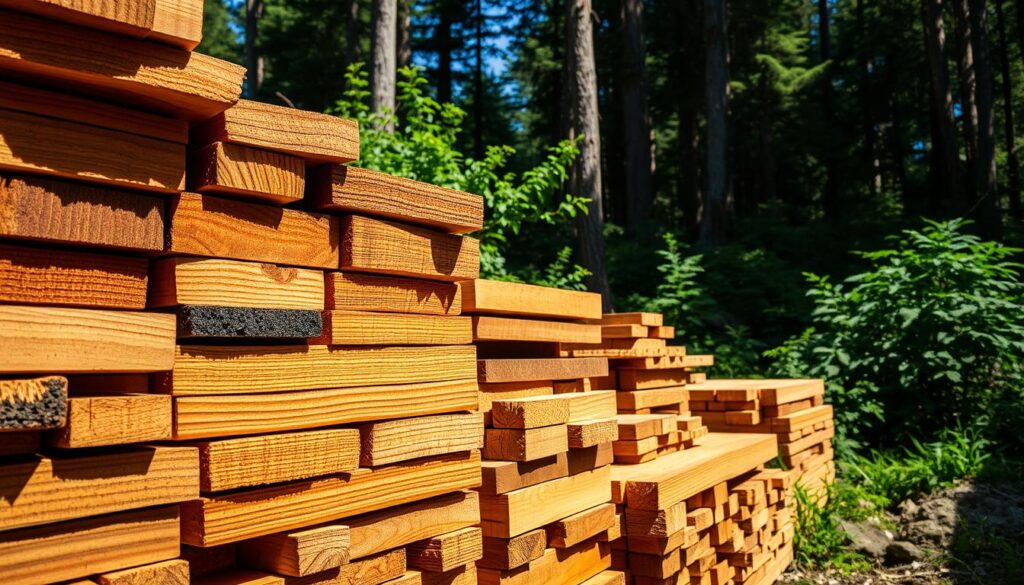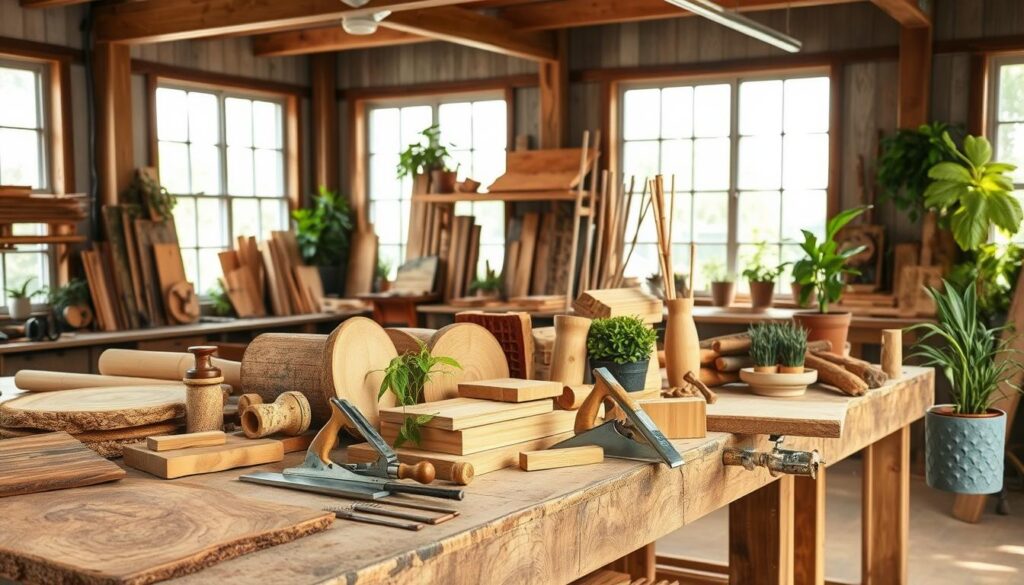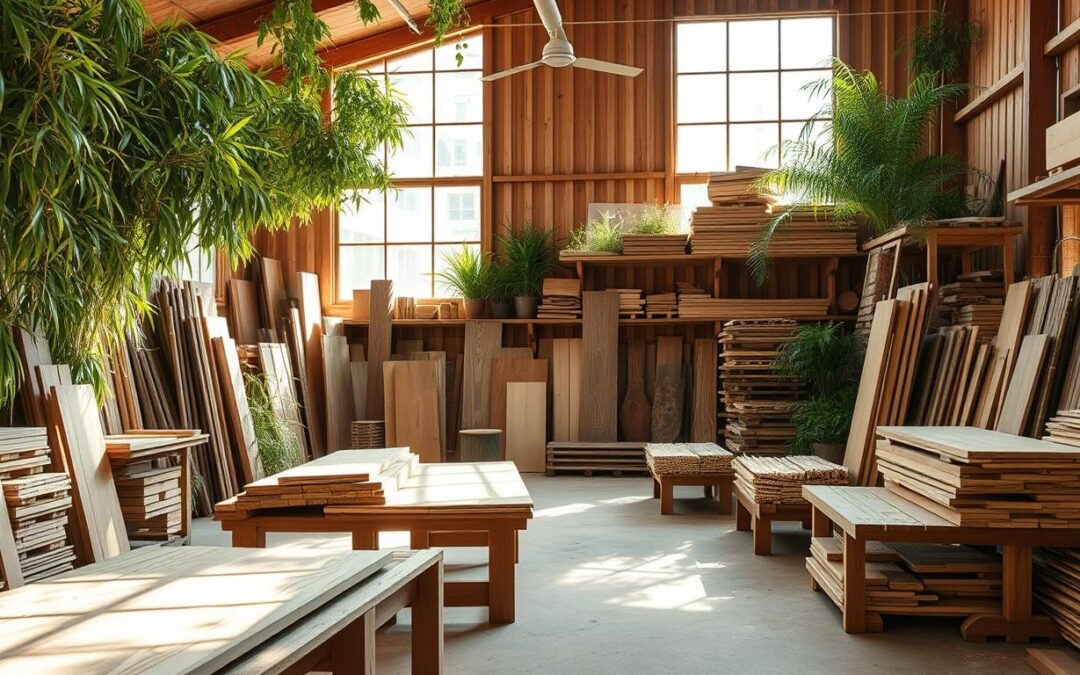In woodworking, caring for the environment is key. Woodworkers now look for green alternatives to old materials and methods. This article dives into sustainable wood options and new ways to make projects that are good for the planet and last long.
Key Takeaways
- Discover sustainable woodworking materials like recycled and reclaimed wood, FSC-certified lumber, and renewable options such as bamboo.
- Learn how to incorporate eco-friendly practices into your woodworking, including minimizing waste and maximizing efficiency.
- Explore the environmental benefits of sustainable woodworking, from reducing carbon footprint to supporting responsible forestry.
- Understand the importance of sustainable woodworking and its impact on the environment.
- Gain insights into the latest trends and innovations in the world of eco-friendly woodworking.
The Importance of Sustainable Woodworking
Sustainable woodworking is key to reducing the harm caused by traditional methods. It helps prevent deforestation, saves habitats, and cuts down on greenhouse gas emissions. By choosing sustainable woodworking, we can lower our carbon footprint and help protect our planet’s resources.
Environmental Impact of Traditional Woodworking
Traditional woodworking often harms the environment. It leads to deforestation and disrupts ecosystems. This not only uses up natural resources but also increases carbon dioxide in the air, contributing to climate change. Also, moving wood products long distances adds to the environmental problem.
Benefits of Eco-Friendly Wood Products
Eco-friendly wood products, like those with the Forest Stewardship Council (FSC) label, have many advantages. They come from forests that are managed well, protecting wildlife and ensuring trees keep growing. These products also have a smaller carbon footprint and support green forestry, making them better for the environment.
By choosing sustainable woodworking, we can all help lessen the harm our craft causes. We can use recycled materials and improve how we make things. This way, woodworkers can be good stewards of the earth.
“Sustainable woodworking is not just a choice, but a responsibility we all share to safeguard our planet for future generations.”
Recycled and Reclaimed Wood
Recycled and reclaimed wood are key in sustainable woodworking. They offer a wealth of eco-friendly options. By using discarded wood, you can make stunning furniture and crafts. This also helps reduce your environmental impact through wood waste utilization.
Upcycling Discarded Wood for Furniture and Crafts
Working with recycled wood is rewarding. It gives old materials a new life, avoiding landfills. You can turn old pallets, barn boards, and construction lumber into unique pieces. Think rustic coffee tables, charming shelves, or intricate wall art.
Wood Waste Utilization in Woodworking
- Maximize the use of every scrap: Aim for zero waste by finding creative ways to use even small offcuts and sawdust.
- Explore wood-based composites: Use recycled wood products like engineered wood panels or wood-plastic composites in your projects.
- Support local wood recycling programs: Help organizations that collect and distribute reclaimed wood, keeping valuable resources from waste.
| Benefit | Impact |
|---|---|
| Reduced environmental impact | Using reclaimed and recycled wood lowers your carbon footprint and keeps materials out of landfills. |
| Unique aesthetic appeal | The natural look and imperfections of recycled wood add a unique, rustic charm to your projects. |
| Cost-effective materials | Repurposing discarded wood is often cheaper than buying new, virgin lumber. |
Using recycled and reclaimed wood in your projects is rewarding and impactful. It helps create a more sustainable future. By upcycling wood waste, you make beautiful, eco-friendly pieces with a unique story.
FSC-Certified Lumber
Using FSC-certified lumber is key in sustainable woodworking. The Forest Stewardship Council (FSC) is a global group that pushes for responsible forest management. By picking FSC-certified wood, woodworkers know they’re using wood from well-managed forests.
The FSC checks many things, like keeping forests diverse and protecting workers. This means the wood you choose helps the environment and supports forests for the future.
| Benefits of FSC-Certified Lumber | Sustainable Forestry Practices |
|---|---|
|
|
Choosing fsc-certified lumber helps woodworkers support sustainable forestry practices. This choice is good for the planet and meets the need for green products.

“Sustainable forestry is not just about protecting the trees; it’s about preserving the delicate balance of the entire ecosystem.”
Sustainable Woodworking Materials
In the quest for eco-friendly woodworking, new materials have come to the forefront. Bamboo and other plant-based options are durable and sustainable. They open up new possibilities for woodworkers, making projects more creative and responsible.
Bamboo: A Renewable and Durable Option
Bamboo is a fast-growing grass that’s gaining popularity in woodworking. It’s as strong as steel, making it perfect for many projects. Its ability to grow quickly and regenerate without replanting makes it a great choice for bamboo woodworking.
Exploring Alternative Plant-Based Materials
There’s more to sustainable woodworking than bamboo. Materials like cork, agricultural waste, and mycelium-based composites offer unique benefits. Using these sustainable wood alternatives can reduce your environmental impact and add new design elements to your work.
| Material | Sustainability | Key Properties | Applications |
|---|---|---|---|
| Bamboo | Highly renewable, fast-growing | Exceptional strength, durability | Furniture, home decor, utensils |
| Cork | Harvested from bark, renewable | Lightweight, water-resistant, insulating | Flooring, wall coverings, accessories |
| Agricultural Waste | Repurposed from agricultural byproducts | Unique textures, varied properties | Panels, boards, decorative elements |
| Mycelium Composites | Grown from fungal mycelium, biodegradable | Lightweight, customizable, fire-resistant | Packaging, insulation, building materials |

“Sustainable woodworking is not just about using the right materials, but also about embracing a mindset that prioritizes the health of our planet.”
As you delve deeper into sustainable woodworking, discover the endless possibilities of these innovative materials. From bamboo’s strength to the unique qualities of other options, the future of eco-friendly woodworking is bright. It offers a chance to create beautiful, responsible, and environmentally-conscious projects.
Green Woodworking Techniques
Green woodworking is all about being sustainable and eco-friendly. It helps you make beautiful wood items while being kind to the planet. This approach reduces waste and boosts efficiency.
Minimizing Waste and Maximizing Efficiency
Green woodworking focuses on cutting down waste. It’s about using materials wisely and finding new uses for scraps. Start by planning your projects well and cutting parts accurately.
Look for creative ways to use offcuts and scraps. This way, you can make the most of every piece of wood.
- Use computer-aided design (CAD) to plan your projects better and waste less.
- Follow the Japanese idea of Mottainai to use resources wisely and avoid waste.
- Get creative with offcuts and scraps. Turn them into small decor items or even furniture parts.
Green woodworking also aims to be more efficient. By improving your workflow and using the right tools, you can work smarter. This saves energy and helps the environment.
- Choose high-quality, energy-saving power tools to cut down on waste and energy.
- Apply lean manufacturing ideas to manage your materials better and work more efficiently.
- Try using hand tools. They’re often better for the environment and can be more efficient.
By using green woodworking techniques, you can make amazing wood items that are good for the planet. These practices help reduce waste, make your work more efficient, and connect you closer to nature.
Carbon-Neutral Woodcrafts
Modern woodworking focuses on sustainability. More people want eco-friendly products. So, carbon-neutral woodcrafts are becoming popular. But, what does it mean to make carbon-neutral woodcrafts? How can woodworkers lessen the sustainable woodworking impact of their work?
To make carbon-neutral woodcrafts, we need to understand the carbon footprint of woodworking. This includes the raw materials, making the product, and shipping it. Woodworkers can reduce their carbon emissions by looking at these steps closely.
Strategies for Carbon-Neutral Woodcrafts
- Use reclaimed or recycled wood to cut down on new timber needs.
- Make production more efficient to use less energy and waste.
- Try renewable and biodegradable materials like bamboo instead of wood.
- Plant trees or support green energy to offset carbon emissions.
- Choose local materials and shipping to lower transportation carbon.
By using these strategies, woodworkers can make carbon-neutral woodcrafts. These products meet the demand for sustainability and help make the world greener.
“The true measure of success in woodworking is not just the beauty of the finished product, but the positive impact it has on the environment.”
Conclusion
Woodworking is changing, moving towards a greener future. You’ve learned about many eco-friendly materials and methods. These can make your projects beautiful and last long while helping the planet.
There are many ways to be green in woodworking. You can use FSC-certified wood or bamboo. You can also turn old wood into something new. These choices help save resources and inspire others to be green too.
Every small step you take towards being green matters a lot. Use eco-friendly materials and methods in your woodworking. This way, you can help make a big difference in your community and beyond. Together, we can create a world where being creative and caring for the environment go hand in hand.
FAQ
What are some sustainable woodworking materials I can use?
You can use recycled and reclaimed wood, FSC-certified lumber, bamboo, and plant-based alternatives. These choices help reduce your environmental impact. They also support sustainable forestry practices.
How can I incorporate recycled and reclaimed wood into my projects?
Upcycling discarded wood is a great way to reduce waste. You can use wood from construction sites or old furniture. This approach creates unique, one-of-a-kind projects.
You can also find ways to use wood waste in your projects.
What is the importance of using FSC-certified lumber?
FSC-certified lumber comes from responsibly managed forests. This promotes sustainable forestry and preserves natural resources. By choosing FSC-certified lumber, you help reduce your environmental impact.
This choice also supports a more sustainable future.
How can I incorporate bamboo and other plant-based materials into my woodworking?
Bamboo is a renewable and durable material for various woodworking projects. It’s great for furniture and decorative items. Exploring plant-based materials adds unique textures and characteristics to your work.
What are some green woodworking techniques I can use to minimize waste and maximize efficiency?
Use careful material planning and repurpose offcuts to reduce waste. Adopting green woodworking techniques makes your processes more sustainable. This approach helps minimize waste and boosts efficiency.
How can I create carbon-neutral woodcrafts?
To make carbon-neutral woodcrafts, consider the materials’ source, production energy, and project lifespan. Understanding and reducing your woodworking’s carbon footprint is key. This way, you can create more sustainable woodcrafts.

